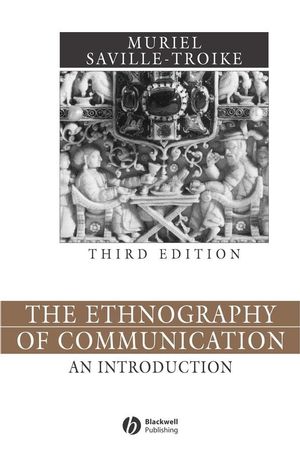The Ethnography of Communication: An Introduction, 3rd EditionISBN: 978-0-631-22841-7
Hardcover
336 pages
December 2002, Wiley-Blackwell
 This is a Print-on-Demand title. It will be printed specifically to fill your order. Please allow an additional 10-15 days delivery time. The book is not returnable.
|
||||||
1. Introduction:.
Scope and Focus.
Method.
Historical Background.
Significance.
Organization of the Book.
2. Basic Terms, Concepts, and Issues:.
Patterns of Communication.
Communicative Functions.
Speech Community.
Communicative Competence.
The Competence of Incompetence.
Units of Analysis.
Categories of Talk.
Language and Culture.
Social Structure and Ideology.
Routines and Rituals.
Universals and Inequalities.
3. Varieties of Language:.
Language Choice.
Diglossia and Dinomia.
Code-Switching and Style-Shifting.
Code-Markers.
Varieties Associated with Setting.
Varieties Associated with Activity Domain.
Varieties Associated with Region.
Varieties Associated with Ethnicity.
Varieties Associated with Social Class, Status, and Role.
Varieties Associated with Role-Relationships.
Varieties Associated with Sex.
Varieties Associated with Age.
Varieties Associated with Personality States and ‘Abnormal’ Speech.
Non-Native Varieties.
4. The Analysis of Communicative Events:.
Relationship of Ethnographer and Speech Community.
Types o f Data.
Survey of Data Collection and Analytic Procedures.
Identification of Communicative Events.
Components of Communication.
Relationship among Components.
Elicitation within a Frame.
Analysis of Interaction.
Sample Analyses of Communicative Events.
Further Illustrations of Ethnographic Analysis.
5. Contrasts in Patterns of Communication:.
Comparative Rhetoric.
Historical Development.
Ethnographic Perspective.
Establishing Validity.
Situated Event Analysis.
Other Data Collection and Analytic Procedures.
Cross-Cultural Communication.
Concepts of ‘Face’;.
Constructing an Unseen Face.
6. Attitudes toward Communicative Performance:.
Methodology.
Attitudes Toward Language and Language Skills.
Attitudes Toward Languages and Varieties.
Stereotyping.
Appropriateness.
Language and Identity.
Language Maintenance, Shift, and Spread.
Taboos and Euphemisms.
7. Acquisition of Communicative Competence:.
Early Linguistic Development.
Social Interaction.
Language and Enculturation.
Definition of Stages and Roles.
Communicative Strategies.
Formulaic Expressions.
Nonverbal Communication.
Peer Influence and Extended Acquisition..
Speech Play.
Formal Education.
Multilingual Contexts..
Children’s Beliefs about Language.
8. Politeness, Power, and Politics:.
Language and Politics.
Language and Social Theories.
Linguistic Signs of Power.
Linguistic Performances of Power.
Linguistic Resistance and Rebellion.
Language Planning.
Responsibilities and Limitations.
9. Conclusion:.
References.
Index of Languages.
General Index.



